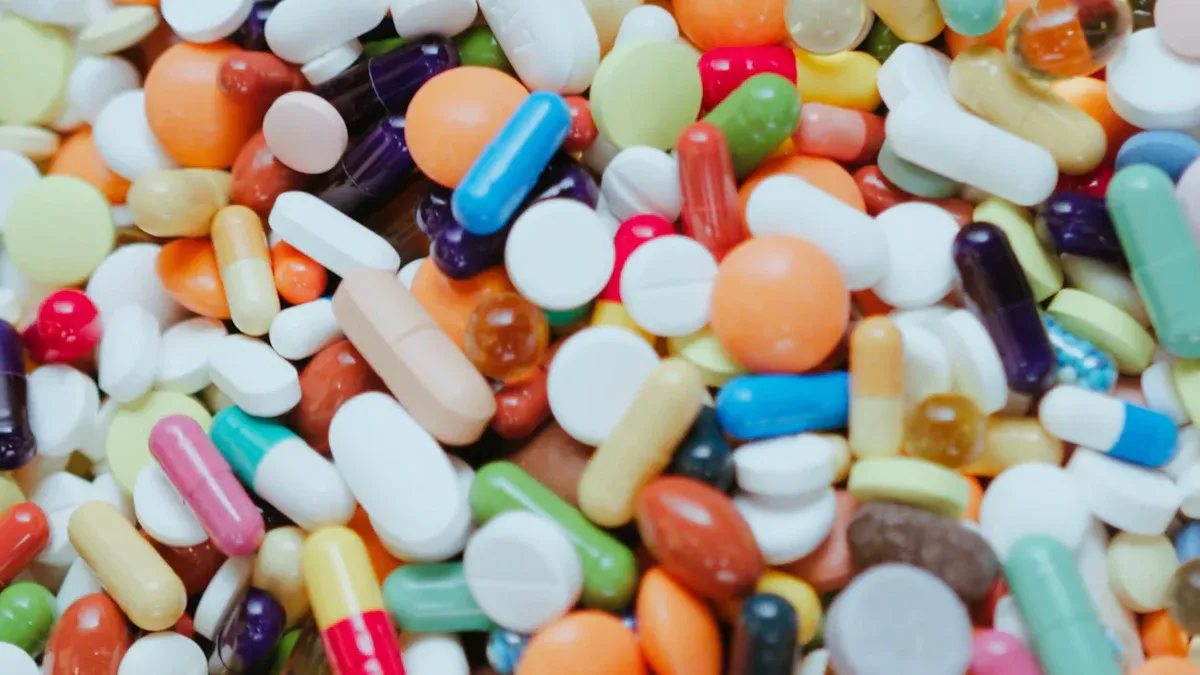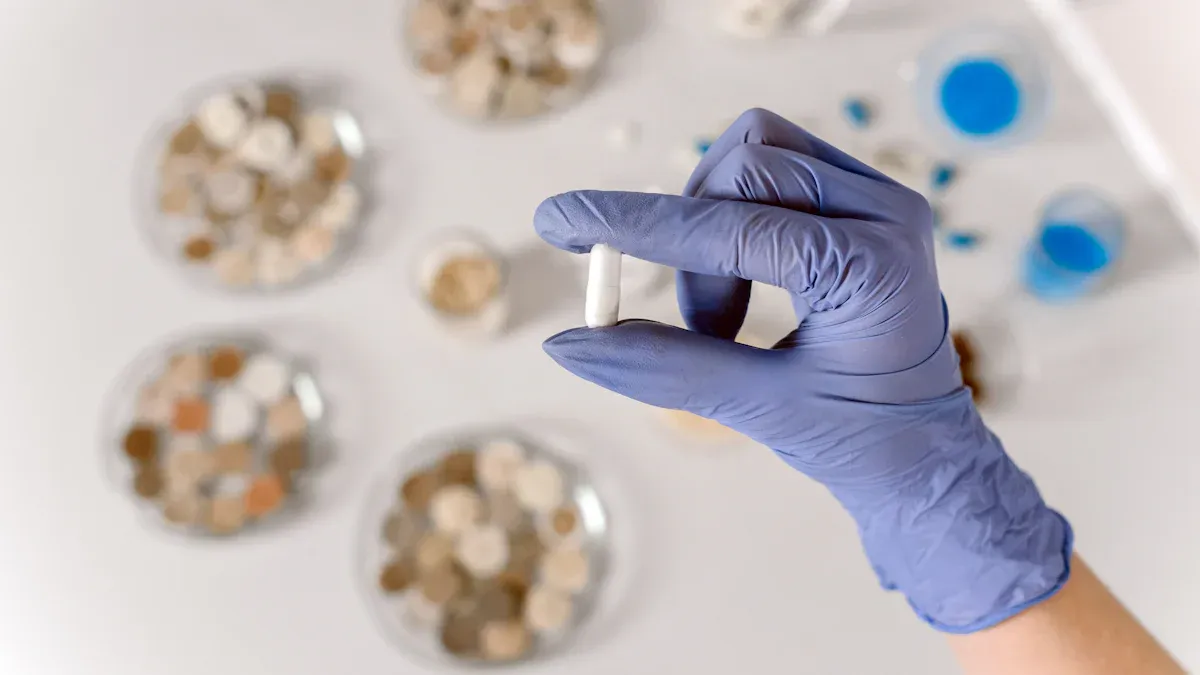You use magnesium stearate as a special lubricant in making tablets. It helps tablets slide out of machines without getting stuck. This dry lubricant makes a thin layer that stops powders from sticking together. Magnesium stearate is popular in the pharmaceutical industry. It helps keep tablets the same and easy to make. Lately, manufacturers want cleaner, plant-based types and better ways to make it. These changes help make magnesium stearate safer and more dependable for your tablets.
Key Takeaways
Magnesium stearate is an important lubricant in making tablets. It helps powders move easily. It stops powders from sticking to machines.
Using the right amount of magnesium stearate matters a lot. If you use too much, tablets can get weak. Tablets may also take longer to dissolve.
Magnesium stearate makes tablets better by keeping their size and weight even. This helps give the right amount of medicine in each tablet.
Safety is very important. Health experts say magnesium stearate is safe. You must handle it the right way. You should follow all rules.
There are other choices besides magnesium stearate. These include sodium stearyl fumarate and stearic acid. Each one has good and bad points. Pick the best one for your needs.
Magnesium Stearate in Pharmaceuticals

Properties
Magnesium stearate is used a lot in medicines. It is a white, soft powder. It feels smooth and has a light smell. You cannot mix it with water, ethanol, or ether. But it can mix with hot water and ethanol. Magnesium stearate does not like water. This helps it cover tablet pieces and keep them apart. It does not melt easily, so it stays strong when making tablets.
Tip: The amount of stearate and palmitate in magnesium stearate changes how powders move and how strong tablets are. More stearate means powders move better but tablets are weaker. The size of the powder and water in it also change how tablets turn out.
Here is a table that lists some key properties:
Property | Description |
|---|---|
Appearance | White, soft powder with a light smell and smooth feel. |
Solubility | Does not mix with water, ethanol, or ether; mixes with hot water and ethanol. |
Lubricant Characteristics | Used as a lubricant, anti-adhesive, and glidant in making tablets. |
Impact on Tablet Formulation | Helps powders flow and stick together; good for direct compression. |
Magnesium stearate does not mix with water, which is important for tablets. It helps tablets slide out and changes how fast they break apart. If you use too much, tablets can get weak and take longer to dissolve.
Common Uses
Magnesium stearate is found in almost all medicines. It is used in many products, like:
Chewable tablets
Effervescent tablets
Hard capsules
Lozenges
Orally dispersible tablets
Swallowable tablets
People pick magnesium stearate because it works well, is simple to use, and saves money. Using magnesium stearate nf helps keep costs down and makes good products. Many companies like it because it fits most ways to make tablets. When you use magnesium stearate nf, you get a trusted ingredient for making medicines.
Role of Magnesium Stearate in Tablet Manufacturing

Lubrication Mechanism
You use magnesium stearate as a lubricant when making tablets and capsules. It helps powders move easily during pressing. Magnesium stearate makes a thin layer around each powder piece. This layer acts like a shield. It stops powders from sticking to the metal parts of the machine. When you add magnesium stearate, it lowers friction between the powder and the press. This makes it easier to make tablets. It also helps tablets come out of the machine smoothly every time.
Different types of magnesium stearate can work in different ways. If you mix it longer, the powder packs better and slides more easily. Some kinds of magnesium stearate work better because of their size and surface area. Using the right type can make tablets come out with less force. It also gives better results when pressing the tablets.
Note: Magnesium stearate covers the outside of the active ingredients. This helps stop the powder from sticking to the punch during pressing. When more of the surface is covered, sticking goes down fast. The way the punch, magnesium stearate, and ingredients touch each other can change how much sticking happens. This is true at different pressures.
Here is a table that shows how magnesium stearate helps stop friction and sticking:
Evidence Description | Findings |
|---|---|
Role in reducing punch sticking | Magnesium stearate covers the ingredients, so they stick less. |
Impact of surface area coverage | More coverage means less sticking. |
Interplay of forces | The punch, magnesium stearate, and ingredients all affect sticking. |
Anti-Adherent and Glidant Effects
Magnesium stearate does more than just act as a lubricant. It is also used as an anti-adherent and glidant in making tablets and capsules. As an anti-adherent, magnesium stearate keeps powders from sticking to the punches and dies. This helps tablets stay smooth and not break apart.
As a glidant, magnesium stearate helps powders flow better. It changes how powders slide past each other by changing the contact area. This lowers the forces that make powders clump together. Powders move better and do not stick as much. You can test these effects using angle of repose, avalanche time, powder rheometry, and shear cell tests.
Here is a table that explains the anti-adherent and glidant effects:
Key Findings | Description |
|---|---|
Effect on Flowability | Magnesium stearate changes the contact area, so powders slide better and break less. |
Measurement Techniques | You can test flow with angle of repose and other tests. |
Glidant Effect | Works best when powders stick together; less effect if powders already flow well. |
Composition | Magnesium stearate is a sticky powder used in tablets and capsules. |
Commercial Availability | Most magnesium stearate is sold as blends for better lubrication. |
You usually add magnesium stearate in small amounts, from 0.25% to 5% by weight, when making medicines. This helps powders flow better and stops problems like rat-holing in tablet presses. Magnesium stearate makes it easier to press tablets, lowers friction, and helps make tablets and capsules faster.
Tip: If you want powders to flow better and have less friction, magnesium stearate is a good choice in medicines. It helps you make tablets that are even and easy to use.
Benefits and Drawbacks
Manufacturing Efficiency
Magnesium stearate helps make tablets faster and easier. It lowers friction, so machines work better. Powders move smoothly and do not clump together. This means each tablet has the right amount of medicine. You can make more tablets in less time.
Magnesium stearate is a lubricant that makes machines run faster.
It helps powders flow and stops clumps from forming.
You get fewer slowdowns and can make more tablets.
But, if you make tablets too fast, machines can get worn out. Using more magnesium stearate or adding it differently can change how good the tablets are.
Scientists used a compaction simulator to test this. They saw that when you make tablets faster with 1% magnesium stearate, it takes more force to push tablets out. Less lubricant gets to the sides, so there is more rubbing.
Impact on Tablet Quality
Magnesium stearate helps tablets look nice and work well. Tablets are the same size and weight, so you get the right dose. Powders press together smoothly, so tablets are not too hard or too soft. Tablets are easier to coat and do not stick as much.
Magnesium stearate helps powders move, so tablets are even.
You get the same amount of medicine in each tablet.
Tablets are not too hard or too soft.
Coating is easier, and tablets look better.
Dissolution and Brittleness
You need to be careful with how much magnesium stearate you use. Too much can make tablets break easily. If you use a lot or mix it for a long time, tablets dissolve slower. This is because magnesium stearate makes a water-hating layer around the medicine.
Factor | Effect on Drug Dissolution |
|---|---|
Concentration of MgSt | More magnesium stearate slows how fast tablets dissolve |
Purity of MgSt | Some types slow down dissolving more than others |
pH of Medium | Changes how fast tablets break up |
Drug Solubility | Some drugs dissolve slower with magnesium stearate |
Hydrophobic Layer Formation | Magnesium stearate makes a film that slows breakup |
Magnesium stearate can make tablets weaker. The powder covers the pieces, so they do not stick together as well. Tablets can break more easily, especially with some ingredients. You should use just enough to keep tablets strong and working right.
Safety and Handling
Safety Profile
Magnesium stearate is safe to use in making medicines. Many tests show it does not hurt your genes or body. Scientists checked it with bacteria and animals. They did not find any genetic problems. There were no changes in chromosomes. Big health groups say magnesium stearate is safe:
Magnesium stearate passed safety tests with bacteria and animals.
It did not cause gene changes or chromosome problems.
No bad effects showed up in long-term tests.
The European Food Safety Authority said magnesium stearate was safe in 1991.
Experts found no cancer risk or problems for having children.
The FDA says magnesium stearate is safe to use.
Some people may get mild stomach aches or diarrhea if they are sensitive. You should read labels if you have allergies.
Study Type | Findings |
|---|---|
In vitro study (2007) | Tablets with magnesium stearate dissolved slower, but the medicine still worked. |
Earlier study | Slower dissolving did not change how much medicine got into the blood. |
Some people worry about liver or immune problems, but there is no strong proof.
Regulatory Aspects
You must follow strict rules when using magnesium stearate in medicines. Groups like the FDA and EFSA want you to use pure magnesium stearate. They care about safety and the environment.
The FDA wants magnesium stearate to be pure and safe.
World health groups check purity, safety, and the environment.
Suppliers must keep high standards to sell magnesium stearate everywhere.
You help keep patients safe by following these rules. You also make sure your tablets meet world standards.
Handling Guidelines
You should keep magnesium stearate in a cool, dry place. Keep it away from water and strong smells. Always use clean tools and wear gloves when you touch it. This keeps your tablets clean and safe.
Store magnesium stearate in closed containers to keep it clean.
Wear gloves and masks when you handle it.
Clean your work area before and after using magnesium stearate.
Tip: Always check the expiration date and batch number before using magnesium stearate in medicines.
Alternatives to Magnesium Stearate
Other Lubricants
There are many other lubricants you can use in tablets. Some common ones are:
Calcium stearate
Poloxamers
Sodium lauryl sulfate
Glyceryl dibehenate
Polyethylene glycol
Sucrose fatty acid esters
Sodium stearyl fumarate mixes well with water. It helps tablets break up faster. Stearic acid is mostly used in food and makeup. But you can use it in tablets if you need to. Glyceryl dibehenate and poloxamers help powders move and stop sticking.
Tip: Always check how each lubricant works with your main ingredient. Some can change how fast your tablet breaks up or how strong it is.
Comparison
You should look at the good and bad sides of each lubricant before picking one. The table below shows how some popular choices compare:
Excipients | Advantages | Disadvantages |
|---|---|---|
Sodium Stearyl Fumarate | Helps tablets break up faster; works with more ingredients; stable | Can cost more than magnesium stearate |
Stearic Acid | Used in food and makeup; safe for many things | Not used as much in tablets; may not work as well |
Magnesium Stearate | Used a lot; saves money; good at stopping sticking | Can slow tablet breakup; may not work with all ingredients |
Sodium stearyl fumarate helps tablets break up quickly. It works well with sensitive ingredients. Magnesium stearate does not mix with water, so it can slow down tablet breakup. Stearic acid is safe but not used as much in tablets.
When you pick a lubricant, you need to think about a few things:
The kind of lubricant changes how hard the tablet is and how fast it breaks up.
The amount you use is important. Too little can make tablets stick. Too much can make them weak.
How long you mix the powder matters for how well it works.
The lubricant should match your main ingredient.
Lubricants can mix with other things and change how your tablet works.
Some lubricants, like micronized stearic acid, work well and cause fewer problems. Magnesium stearate can make tablets weaker and slow down how fast they break up. Lubricants that mix with water, like sodium stearyl fumarate, help tablets break up and get wet faster.
Note: You should try different lubricants to find the best one for your tablet. Picking the right one helps you make tablets that are strong, safe, and work well.
You use magnesium stearate to help make tablets better. It makes tablets smooth and strong. It also helps keep them safe.
Magnesium stearate lowers friction in machines.
It helps powders move and keeps tablets steady.
You get good quality and the right amount of medicine.
Factor | Why It Matters |
|---|---|
Regulatory Compliance | You follow FDA rules for safe medicines. |
Safety Assurance | Food-grade lubricants keep your product safe. |
Quality Commitment | Trusted lubricants help people trust your tablets. |
New studies will help you pick the best lubricant. You can make tablets safer and better by learning about each choice.
FAQ
What does magnesium stearate do in tablet manufacturing?
Magnesium stearate helps powders move without sticking. It stops tablets from getting stuck in machines. Tablets are easier to press and do not break as much.
Can magnesium stearate affect how fast tablets dissolve?
Yes, magnesium stearate can make tablets dissolve slower. Using too much means tablets break up slower in your stomach. You need to use the right amount for good results.
Is magnesium stearate safe for you?
You can use magnesium stearate safely in medicines. Health experts and the FDA say it is safe. Most people are fine, but some may get a mild stomach ache.
Are there plant-based options for magnesium stearate?
There are plant-based kinds of magnesium stearate. Many companies sell it for people who want vegan or cleaner products. Always look at the label to know where it comes from.
What are some alternatives to magnesium stearate?
You can use sodium stearyl fumarate, stearic acid, or calcium stearate. Each one works in its own way. You should test which one is best for your tablets.

